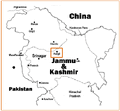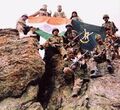Dras
| Author:Laxman Burdak, IFS (R) |
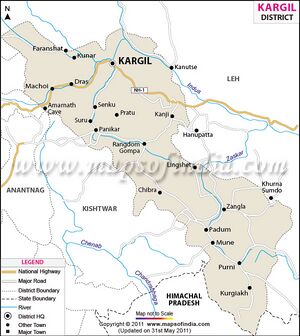
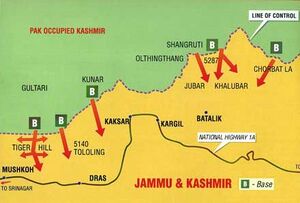
Dras (द्रास) is a hill station in the Kargil district of the union territory of Ladakh in India.
Variants
- Dras Valley
- Dras River
- Drass - The government's official spelling of the town is Drass.
- Hem-babs - which means "snow land"
Location
It is on the NH 1 (former name NH 1D before renumbering of all national highways) between Zoji La Pass and Kargil town. A tourist hub for its high altitude trekking routes and tourist sites, it is often called "The Gateway to Ladakh".[1]
Etymology
Traditionally, Dras is known as Hem-babs, which means "snow land" with the word "Hem" meaning snow. The average temperature of Dras in winter is -20 degrees Celsius.[2]
Dras is often called "The Gateway to Ladakh". It is at a height of 10,800 feet (3,300 m)[3]Dras lies in the centre of the valley of the same name (Dras valley). Dras is 140 km from Srinagar and 63 km from Sonmarg. Kargil town is further 56 km after Dras on the national highway NH 1 from Srinagar towards Leh.
History
In the princely state of Jammu and Kashmir (1846–1947), Dras was part of the Kargil tehsil of the Ladakh wazarat.[4]
During the invasion by Pakistan in 1947-48, the reinforced Gilgit Scouts, having gone over to Pakistan, attacked the Kargil area on 10 May 1948. The Indian army, which was by now in charge of the defence of Kashmir, sent reinforcements. However, they could not reach Dras in time and Dras fell to the Gilgitis on 6 June 1948. Kargil and Skardu also fell in short order.[5] In November 1948, the Indian Army launched Operation Bison, supported by tanks, and retook Dras and Kargil. Skardu, however, remained under the control of Pakistan.[6] The 1949 ceasefire line runs 12 km north of Dras through Point 5353.[7]
The ceasefire line was renamed the Line of Control in the 1972 Simla Agreement, by which India and Pakistan agreed to respect the line without prejudice to their stated positions.
However, in the early months of 1999, Pakistani soldiers, masquerading as mujahideen, infiltrated into the area and took control of the peaks overlooking Dras and the highway, in particular Tololing, 4 km from Dras, and Tiger Hill, 8 km from Dras. They directed artillery fire at Dras and the highway, leading to the Kargil War. The Indian army cleared the Tololing and Tiger Hill peaks by July 1999.
The people
The major ethnic groups are the Shina people, who speak the Indo-Aryan language Shina, and the Balti people, whose language, Balti, belongs to the Tibetic group. The small town has a majority of people following Islam Sunni Islam (60%), Noorbakshia Islam (20%) and Shia Islam (20%) . The local population is 64% male and 36% female. [8]
Many of the inhabitants of Dras farm, cultivating primary crops like barley. The locals also raise livestock like cattle and ponies. Common foods comprising the diet of the people include potatoes, barley, beef, and drinks like tea.[9]
Jat clans
1. Dras: Hukum Singh Panwar (Pauria)[10] provides Tribal and Geographical Identifications based on India in Greece by E. Pococke, Indian Reprint, Oriental Publishers, Delhi-6. as under:
| S.No. | Name of tribe | From | To | Altered name | Country |
|---|---|---|---|---|---|
| 74. | Dras/Draus/Dravus/Dral* | Himalaya | Alps | Draves | Alps |
2. Shin - H. W. Bellew[11] thinks that The Shin of Gilgit and Dardistan represent the China named by Manu amongst the races of the Kshatriya class, who by their neglect of Brahmanism, gradually sunk to the lower class. The China who thus lapsed from the Kshatriya class are named by Manu along with the Parada, Pahlava, Kirata, Darada, and Khasa ; all which races inhabited the mountainous country between Kabul and Kashmir in which Buddhism long held its strongest sway.
Jat History
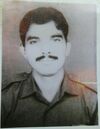
Naik Prabhu Ram Chotia (1968–1999) From Indas, Nagaur, Rajasthan is Martyr of Kargil war on 13 June 1999, Unit-18 Grenadiers. Naik Prabhu Ram Chotiya was a brave soldier of the Indian Army who sacrificed his life during the Kargil War while capturing tololing in Dras Kargil by the Pakistani security forces. He along with his team marched towards tololing and reacquired the tololing on 13th June but he was no more to enjoy the success of team.
Subedar Bahadur Singh - Vir Chakra (posthumous), from village Digiana ( डिगियाना) in district Jammu. He became martyr on 11 June 1999 in Kargil War. He was in Unit - 12 JAK Light Infantry.
Havaldar Madal Lal - Vir Chakra (Posthumous) from village Ban Talab (बन तलब) in Jammu district in Jammu-Kashmir. He became martyr in Kargil War on 5 July 1999. He was in Unit - 18 Grenadiers. He was part of the Commando 'Ghatak' Platoon tasked to capture three strategic bunkers on Tiger Hill, whose gunner Yogendra Singh Yadav was awarded Paramvir Chakra while fighting with 12 Northern Light Infantry of Pakistan in Dras sector of Kargil area to recapture the Tiger hill on 04 July 1999.
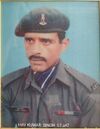
Kumar Singh Sogarwal (Havildar), Vir Chakra, is a Martyr of Kargil War from Uttar Pradesh. He was from village Baseri Kaji in district Agra in Uttar Pradesh. He became martyr on 07 July 1999 during Operation Vijay in Kargil War. He was in Unit-17 Jat Regiment of the Indian Army. He was awarded Vir Chakra for his daring actions of bravery on July 6-7, 1999 in recapturing Pinpal-1 and Pinpal- hills in Dras sector of Jammu and Kashmir.

Subedar Randhir Singh (Kalher) , Vir Chakra , (b. 15 July 1955, d. 3 June 1999) of Balkara village near Charkhi Dadri, Bhiwani district in Haryana, won the Vir Chakra award in Kargil war. His father's name is Sh Sri Chand. A middle school is named Martyr Subedar Randhir Singh middle school Balkara. He was in 18 Grenadier Regiment. He was born in a Hindu Jat family of Kalher gotra.

Naik Digendra Kumar (Paraswal) , born 3 July 1969, is recipient of Maha Vir Chakra, Sena Medal and many other medals of bravery. He was the Best Commando of the Indian Army. Nation's second highest wartime gallantry award Maha Vir Chakra was awarded to Naik Digendra Kumar on 15th August 1999 for his acts of bravery in Kargil War in recapturing Tololing hill on 13 June 1999. He retired from the Indian Army on 31 July 2005.

Mahesh Kumar Nitharwal, from village Dhani Bijawala (Hanspur), Srimadhopur, Sikar, Rajasthan, became martyr on 19.10.2018 in Drass Sector of Jammu-Kashmir due to landslide.

Yash Vir Singh Tomar (4.1.1960-13.6.1999) , Vir Chakra, Aged 39, from Sirsali village in Bagpat district Uttar Pradesh died on 12 June 1999 in Kargil War. He was in Unit-2 Rajputana Rifles.
द्रास
द्रास भारत के लद्दाख़ केन्द्रशासित प्रदेश के करगिल ज़िले में स्थित एक बस्ती है। ३,२३० मीटर (१०,९९० फ़ुट) पर बसा हुआ यह क़स्बा १६,००० से २१,००० फ़ुट के पहाड़ों से घिरा हुआ है। द्रास वादी ज़ोजिला दर्रे के चरणों में है और कश्मीर से लद्दाख़ जाने के लिये यहाँ से गुज़रना पड़ता है, जिस कारणवश इसे 'लद्दाख़ का द्वार' भी कहा जाता है।
जम्मू और कश्मीर की रियासत (1846-1947) में, द्रास लद्दाख वज़रात की कारगिल तहसील का हिस्सा था। 1947-48 में पाकिस्तान द्वारा आक्रमण के दौरान, प्रबलित गिलगित स्काउट्स, पाकिस्तान चले गए, 10 मई 1948 को कारगिल क्षेत्र पर हमला किया। भारतीय सेना, जो अब तक कश्मीर की रक्षा के प्रभारी थी, ने सुदृढीकरण भेजा। हालांकि, वे समय पर द्रास नहीं पहुंच सके और 6 जून 1948 को द्रास गिलगित स्काउट्स द्वारा कब्जा कर लिया। कारगिल और स्कार्दू भी कम में कब्जा कर लिया। [६] नवंबर 1948 में, भारतीय सेना ने टैंक द्वारा समर्थित ऑपरेशन बाइसन को लॉन्च किया, और द्रास और कारगिल को कब्जा कर लिया। हालांकि, स्कर्दू पाकिस्तान के नियंत्रण में रहा। 1949 की युद्धविराम रेखा द्रास से उत्तर में 12 किमी दूर है।.
युद्ध विराम रेखा को 1972 के शिमला समझौते में नियंत्रण रेखा का नाम दिया गया था, जिसके द्वारा भारत और पाकिस्तान लाइन का सम्मान करने के लिए सहमत हुए।
हालाँकि, 1999 के शुरुआती महीनों में, पाकिस्तानी सैनिकों ने मुजाहिदीन के रूप में मुखबिरी करते हुए, इस इलाके में घुसपैठ की और द्रास और राजमार्ग को देखने वाली चोटियों पर नियंत्रण कर लिया, विशेष रूप से टोलोलिंग में, द्रास से 4 किमी और द्रास से 8 किमी दूर टाइगर हिल। उन्होंने द्रास और राजमार्ग पर तोपखाने की आग का निर्देशन किया, जिससे कारगिल युद्ध हुआ। भारतीय सेना ने टोलिंग और टाइगर हिल चोटियों को जुलाई 1999 तक साफ कर दिया।
दुनिया का दूसरा सबसे ठंडा बसेरा: यह भारत के सबसे ठंडे शहरों में से है और सर्दियों में यहाँ तापमान −४५ °सेन्टिग्रेड तक गिर जाता है और −६० °सेन्टिग्रेड तक मापा गया है। कई स्रोतों के अनुसार साइबेरिया के बाद यह दुनिया का दूसरा सबसे सर्द मानवी बसेरा है।
लोग: लद्दाख़-करगिल क्षेत्र में होने के बावजूद द्रास के लोग अधिकतर हिन्द-आर्य जाति की दार्दी उपशाखा के हैं और शीना भाषा नाम की एक दार्दी भाषा बोलते हैं। मुस्लिम बहुसंख्यक हैं लेकिन कुछ बौद्ध धर्मी भी यहाँ रहते हैं।
See also
Gallery
-
Location of Kargil & Dras with respect to the Line of Control
-
Map of Kargil War areas
-
Indian soldiers after winning a battle during the Kargil War
-
Kargil War Memorial
-
Dras war memorial
External links
References
- ↑ "Page on Dras from". ladakh-kashmir.com.
- ↑ Schuh, Dieter (2014). "Drass". Tibet-Encyclopaedia.
- ↑ Singh Negi, Sharad (2002). Cold Deserts of India. Indus Publishing. p. 226. ISBN 8173871272.
- ↑ Karim, Maj Gen Afsir (2013), Kashmir The Troubled Frontiers, Lancer Publishers LLC, pp. 30–, ISBN 978-1-935501-76-3, pp. 30–31.
- ↑ Cheema, Brig Amar (2015), The Crimson Chinar: The Kashmir Conflict: A Politico Military Perspective, Lancer Publishers, pp. 51–, ISBN 978-81-7062-301-4, pp. 48, 102–103.
- ↑ Cheema, Crimson Chinar 2015, pp. 111–112.
- ↑ wami, Praveen (11 August 2000). "Pakistan still occupies key Dras point". The Hindu Business Line.
- ↑ "Page 4. Rambirpur (Drass)". Censusindia.gov.in.
- ↑ Keatinge, Hilary (1993). "The Road to Leh". Aramco World
- ↑ The Jats:Their Origin, Antiquity and Migrations/Appendices/Appendix No.6
- ↑ An Inquiry Into the Ethnography of Afghanistan By H. W. Bellew, The Oriental University Institute, Woking, 1891, p.150


